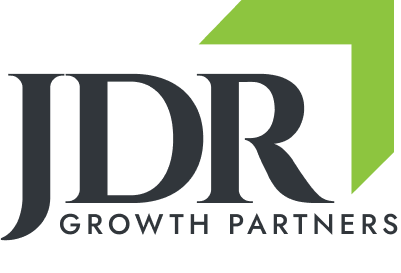It’s human nature to view dilemmas as binary, either-or choices. We all tend to oversimplify complex things into two competing ideologies. This can be useful because it helps us solve problems and move on to the next problem to be solved. It makes us feel productive. But it can make us think we should pick a side when picking a side is not wise. It also becomes an issue when we try to solve them—calling these things ‘problems’ implies there is one single correct answer somewhere. But there often isn’t, and that’s a problem when it takes us too long to realize it.
Do any of these tensions sound familiar?
- Growth vs. Stability
- Centralization vs. Decentralization
- Focus vs. Diversification
- Shared Services vs. Autonomy
- Short-term vs. Long-term Growth
- New Features vs. A Stable Codebase
- Generalist or Specialist
When faced with these tensions, most teams and organizations rush to determine the best or right answer. It might be smarter to first ask a more fundamental question: Is this a problem or a polarity? Too often, we treat conflicts like those listed above as problems to be solved when, in reality, they are polarities to be navigated.
Problems vs. Polarities
A problem is something that can have a right — or best — answer. A solution exists. If we’re deciding between two incompatible tech stacks, this is a problem to be solved. We do our analysis. Weigh the pros and cons, determine which is the best choice, all things considered, and then commit. Problem solved.
This approach is fine if there truly is a decision to be made.
- Which tech stack do we commit to?
- Should we launch this new product?
- Should we acquire this company?
But, when we level this same problem-solving mindset toward things that needn’t be or can’t really be solved, frustration follows. “Should we focus on speed or quality?” Yes, we should focus on both of these things. That is the honest answer. But it doesn’t feel resolved. That’s because these aren’t resolvable problems at all. These are polarities – dilemmas that are ongoing and unsolvable even though they contain seemingly opposing ideas.
Problems offer two ideas that are directly opposed and in conflict. Polarities offer two ideas that are complementary and interdependent. Problems push an either/or mindset. Polarities push a both/and mindset.
Here’s the rub: Polarities are not a problem to be solved, but rather a paradox to be balanced. Sometimes analogies help. Here’s one I borrowed from an instructor at Northwestern’s Family Business Center:
“Think of it like breathing. Breathing isn’t a choice between inhaling or exhaling. If you inhale to the exclusion of exhaling, the negative results show up quickly. And the reverse is also true. The polarity approach says we must both inhale and exhale.”
Finding Balance
What if we had a tool that facilitated good conversations and healthy debate about these complex tensions proactively rather than reactively? Where the goal isn’t a decision but recognition and alignment on more informed actions? The answer to a question like ‘Should we focus on speed or quality?’ could simply be ‘yes’, and it’s really a question of how we should achieve the right balance.
Created by Barry Johnson, PhD, Polarity Mapping is a strategic and visual framework designed to help individuals or teams manage polarities— interdependent pairs of opposites—rather than solve problems with a single solution. It is particularly useful for addressing challenges that involve balancing competing yet complementary forces, such as innovation versus risk management, and can help a team align on a wiser path forward. I was first exposed to the tool at The Center for Creative Leadership in the early 1990s and I’ve used it numerous times since to achieve win-win solutions that lead to improved results.
Introducing, the Polarity Map
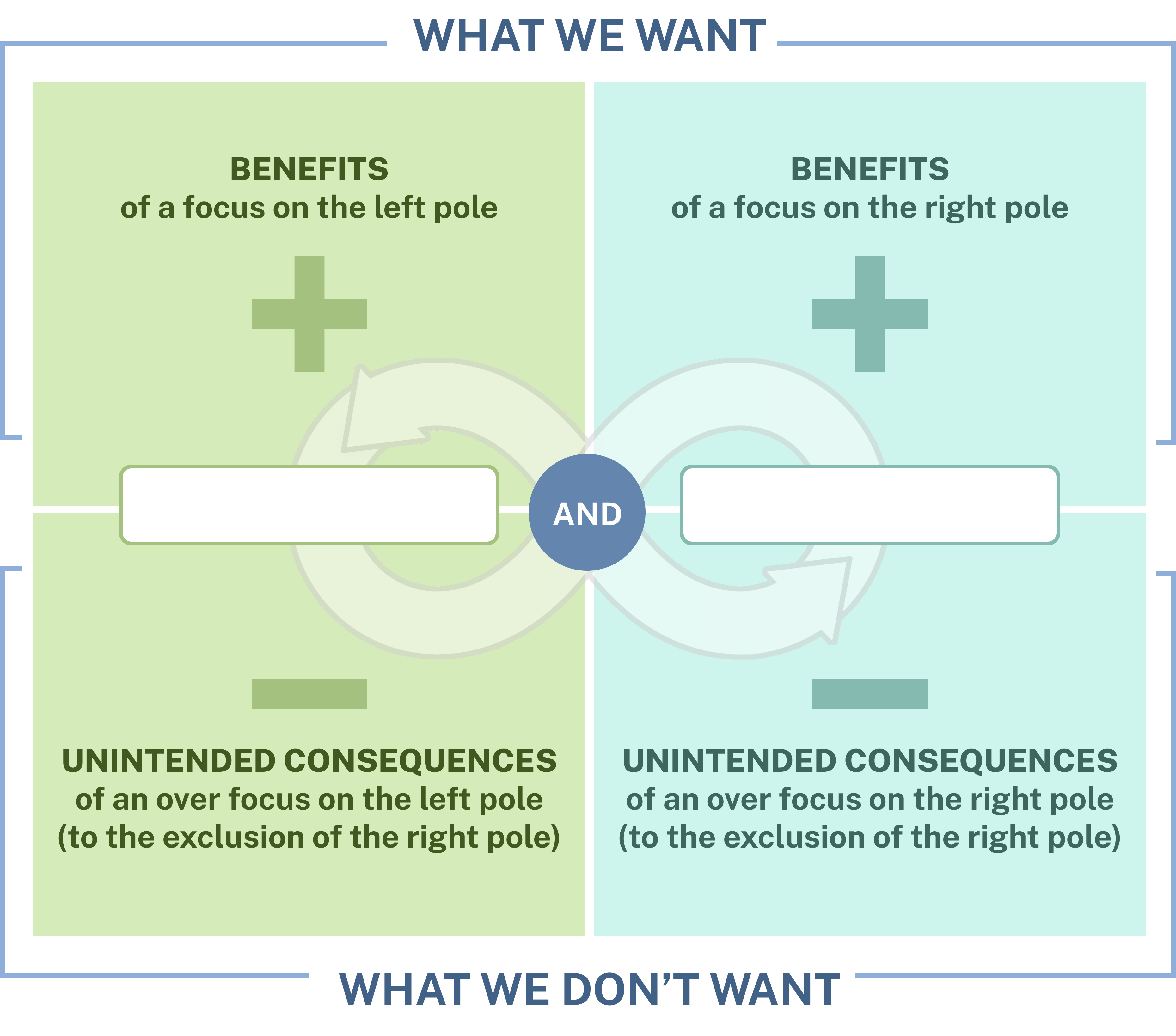
On the surface, it looks like a simple “pros/cons” matrix. But, as with most things, the devil is in the details. First, this little loop below is vital. It shows how we are constantly moving between these four quadrants.

Second, the language we use matters. While we are assessing two poles, we are not evaluating the pros and cons. Rather, the Benefits and Unintended Consequences.
The Tool in Action
Steps to Create a Polarity Map
- Define the challenge and identify interdependent polarities.
- Name the poles neutrally to avoid bias.
- Brainstorm benefits (upper quadrants) and negative or unintended consequences (lower quadrants) for each pole.
- Establish “what we want” or a “greater purpose” that reflects the benefits of balancing both poles.
- Identify “what we don’t want” or “deeper fears” that arise from imbalance.
- Develop action steps to maintain balance while monitoring early warning indicators.
For our explanation, let’s use the tension of “planning” vs. “building” a new software app.
How do we move between these tensions?
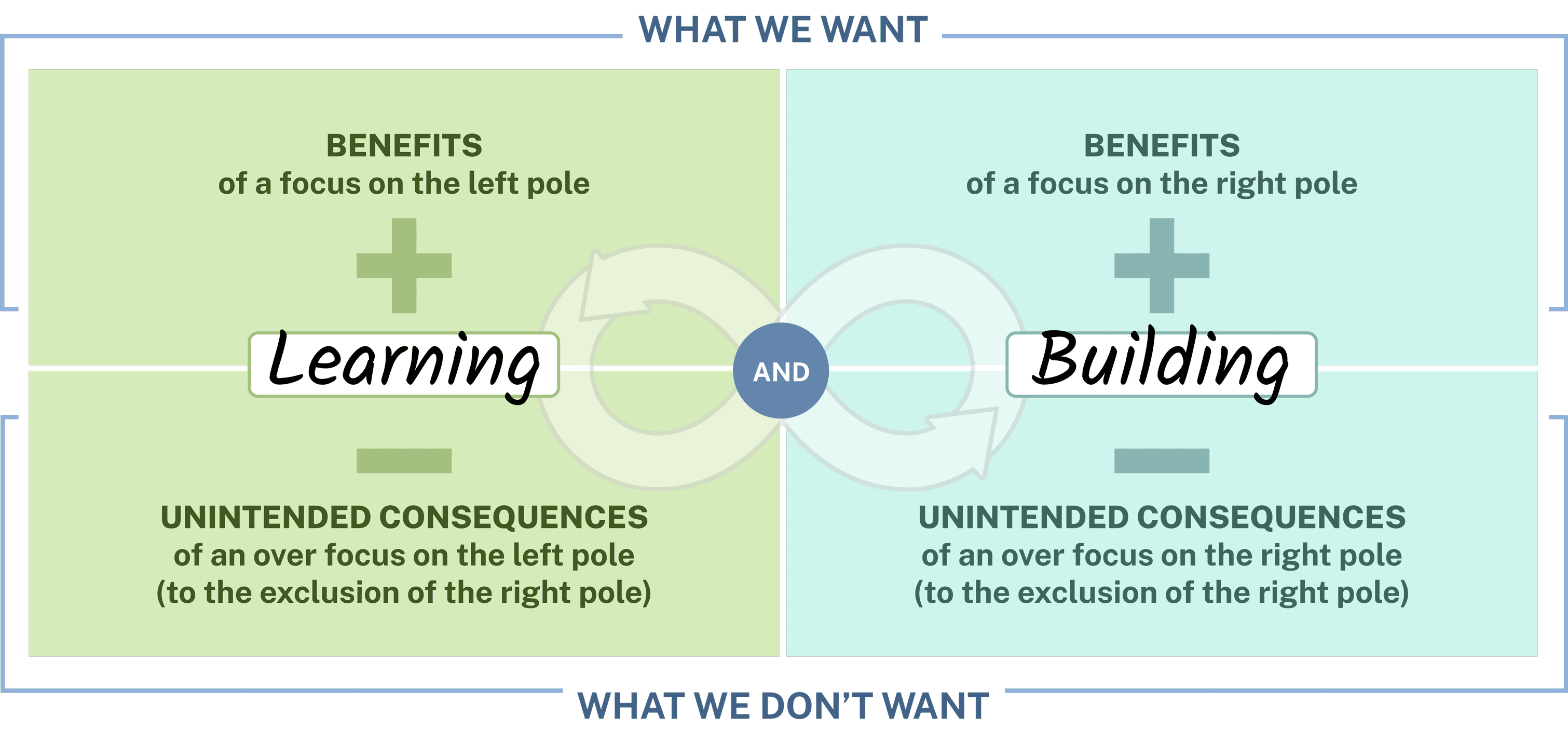
Suppose we decide to double down on “learning”. We have good reasons:
- We’ll be able to make faster decisions when we do move into building.
- We’ll generate deep context / insights that are more useful to ops.
This is all well and good until months later when our zealous focus on “learning” has led to some unintended consequences:
- Teams are stuck in analysis paralysis.
- Competitors beat us to market.
So, what do we do? We swing to the other extreme! We double down on jumping into building. At first, things go great.
- We’ve got something built and released into the market that we can iterate upon.
- We’re delivering real customer value.
But then…
- That new feature you want will take a ridiculous amount of time because we didn’t plan for anything like that.
- We were so busy building things that we forgot to do any real customer research. Turns out no one wants this thing we built.
- Who knows what better ideas we missed out on as we sped along with our first idea?
We didn’t intend for any of these things to happen. And so, the pendulum swings back to the other extreme. Most of the folks who would remember the previous extreme have moved on, so we keep making the same mistakes without learning.
And on it goes.
How do we move between these tensions?
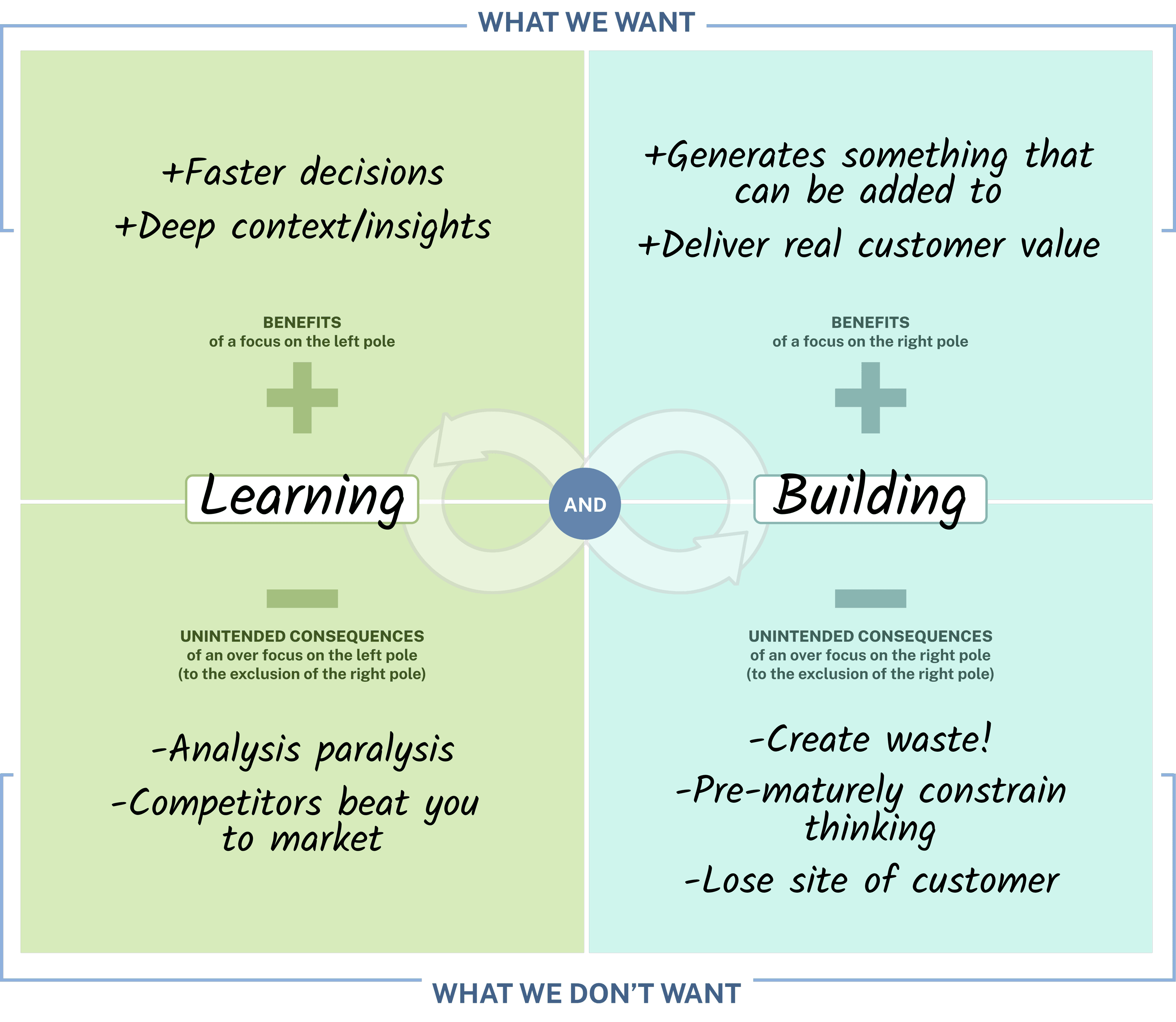
Polarity Mapping enables us to explore all these issues and concerns in an afternoon, setting teams up to work together with a shared sensitivity to all these issues. It’s well worth the time investment. It’s what Steven Covey prescribed in his book, The 7 Habits of Highly Effective People – “Seek First to Understand.” You get the benefit of discussing all these tensions upfront before living through them.
The goal isn’t a decision but rather a recognition of the simultaneous Benefits and Unintended Consequences of the paradox at hand. Polarity Mapping is a tool to help team members with different — and perhaps even competing — perspectives see a more holistic view of a paradox and achieve reconciliation on the wisest path forward before taking action.
The principles of Polarity Mapping align well with win-win negotiating as described by Covey in his seminal book.
While I’ve focused on mapping the Benefits and Unintended Consequences of two polarities, there is more to this tool — and it’s critical because it turns discussion and debate into action. Once you’ve identified all the benefits and unintended consequences, you can move into the margins to address:
- What are the Action Steps to gain or maintain these Benefits?
- What are the Early Warnings of Unintended Consequences?
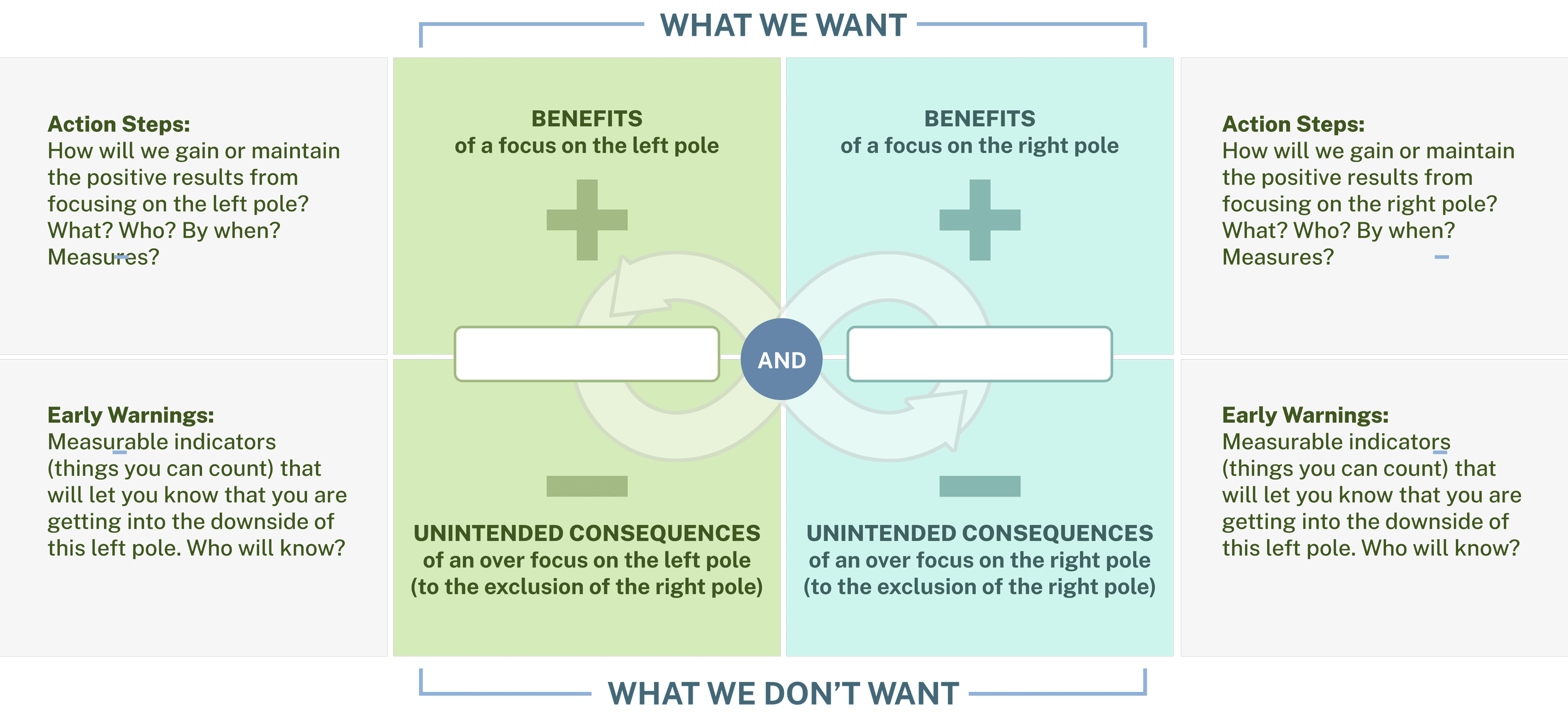
Now, we’ve proactively aligned the team or organization on an intentional path forward, where all voices have been heard and considered in the plan. We have a solid plan to navigate the polarity with confidence and the teamwork needed to win!
As I mentioned earlier, I’ve used this approach for many years to help the teams I led, as well as several clients, resolve disagreements that had been holding them back from achieving their full potential. For example:
- Two family business owners had conflicting desires for their business at later stages in their lives. One wanted to continue growing aggressively, and the other wanted to pump the brakes to guarantee stability and ensure a reliable dividend. The tension had been brewing for many years. Using polarity mapping, we helped them align on a path forward that satisfied both desires.
-
A very successful family business owner was frustrated by a GM who persisted in operating an acquisition independently of the mothership. The GM was a high performer who delivered strong results, but there were obvious synergies that could be capitalized, and it was clear that overall company performance would improve with more cooperation and sharing. Unfortunately, the GM was reticent to be bothered by HQ.
Using polarity mapping with core teams from HQ and the acquired company, we helped both align on a wiser path forward that involved a more integrated partnership in which they capitalized on the strengths of each organization. Years later, the results have exceeded expectations.
Over the years, I’ve found that one of the most important traits separating great leaders from good ones is their ability to navigate ambiguity.
As leaders rise through the ranks, the nature of their challenges shifts— from straightforward problems with clear answers to nuanced dilemmas that require balance, not resolution.
That’s where Polarity Mapping proves invaluable. When used well, it transforms recurring friction into forward momentum—not by choosing one side over the other, but by building shared understanding and a clearer path ahead.
